Intel Broadwell Architecture Preview: A Glimpse into Core M
by Ryan Smith on August 11, 2014 12:01 PM ESTPutting It All Together: Low Power Core M
So far we’ve discussed Broadwell’s architecture on a broad basis, focusing on features and optimizations that are fundamental to the architecture. However to talk about the Broadwell architecture is not enough to fully explain the Core M itself. Though many of Core M’s improvements do come from Broadwell, Intel has also made a number of alterations to everything from the CPU packaging to the process node itself specifically for Core M. It’s the resulting combination of these factors that has allowed Intel to iterate on Broadwell-Y over Haswell-Y, and why Intel is so confident in Broadwell-Y’s capabilities and suitability for mobile form factors.
When it comes to building and configuring Core M, Intel likes to refer to their efforts as the “Fanless Challenge,” reflecting the fact that their biggest goal with Core M is to comfortably get the processor in to 10” tablets under 10mm in thickness that are passively cooled. A big part of getting into such a device is meeting the heat dissipation limitations of the form factor – a 10” tablet under 10mm would require a sub-5W SoC – which is where a lot of Intel’s engineering efforts have gone. Broadwell’s performance optimizations, the GPU optimizations, GPU duty cycling, and the 14nm process all contribute to getting a Core CPU’s power consumption down to that level.
But even that’s still not enough, and for Core M Intel went so far as to give Broadwell-Y its own die and design a low-power optimized version of their 14nm process just for it. This variant is designed to further reduce power consumption by optimizing the resulting transistors for lower power, lower voltage, lower clockspeed operation. By doing this Intel was able to further reduce power consumption in all of the major areas over what would be a traditional 14nm Intel process.
In the resulting 14nm Broadwell-Y process, voltage, capacitance, and leakage were all improved over the traditional 14nm process. Capacitance was reduced by 15%, minimum operating voltages by 10%, and leakage was improved to the point that it reduced SoC power consumption by 10%. The combination of all of these factors serves to significantly lower power consumption over what Intel’s traditional 14nm process would provide.
Working in concert with Broadwell-Y’s 14nm process, Intel has made a number of other changes to further reduce power consumption. Some of these are reflected in Broadwell’s overall design and others are unique to Broadwell-Y, such as using a lower TjMax for Broadwell-Y. By reducing the maximum operating temperature of the chip Intel has been able to realize further power savings by further reducing voltage and decreasing the maximum amount of temperature-dependent leakage the SoC will experience.
Meanwhile Broadwell-Y’s partner in crime, the on-package PCH, has received its own optimizations to reduce power consumption on the SoC’s total power consumption. The PCH itself is not much of a power hog in the first place – it’s still made on Intel’s 32nm process for this and cost reasons – but with such a strong focus on power consumption every watt ends up counting. As a result the Broadwell PCH-LP has seen optimizations that cut its idle power consumption by 25% and its active power consumption by 20%. Further improvements to the PCH’s monitoring hardware also mean it’s more responsive and can be controlled to a finer degree than the Haswell PCH-LP, and Intel has upgraded to a faster audio DSP to improve performance and reduce power consumption there as well.
Feeding all of that silicon in turn is Intel’s second generation Fully Integrated Voltage Regulator (FIVR), which further builds off of Intel’s other optimizations. The 2nd gen FIVR has been tuned for Broadwell-Y’s lower voltages, making the FIVR itself more efficient when delivering power at those voltages. To accomplish this Intel has implemented non-linear vDroop control, which is designed to better control the voltage when workload changes would cause voltage overshoots that waste power. And when even the 2nd gen FIVR isn’t efficient enough, this latest FIVR offers a second mode (LVR Mode) for low voltage/workload situations where the FIVR can be partially bypassed to reduce the FIVR’s power consumption.
Interestingly Broadwell-Y also sees the voltage regulation inductors redesigned and relocated in both the name of power efficiency and space efficiency. We’ll get to the case of space efficiency in a moment, but for power efficiency the new 3D inductors (3DLs) have been placed on the underside of the package, allowing the use of more efficient inductors that waste less power.
This brings us to the final element of Intel’s power optimization efforts, which involve further adjustments to turbo boost as part of Intel’s “hurry up and go to sleep” motto. New for Broadwell-Y is a 3rd power state, PL3, which allows for even greater turbo boosting, but for only a very limited period of time – on the order of milliseconds. PL3 represents the maximum amount of power the device battery can deliver, and while it’s okay to reach this value sparingly, PL3 is a fast drain that is very hard on the battery. The existence of PL3 in this case is as much for battery protection as it is for performance; it allows devices to tap into PL3 power levels on occasion, all the while allowing PL2 (the regular burst limit) to be defined at a safer value below the battery’s limit. Put another way, by knowing PL3 devices know how to stay farther away from it, which in the long run is what’s best for battery reliability.


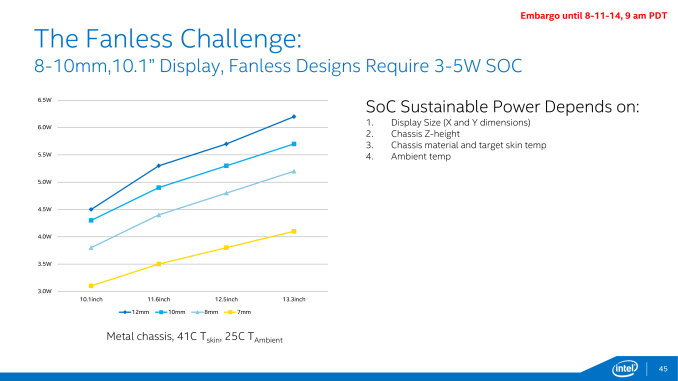
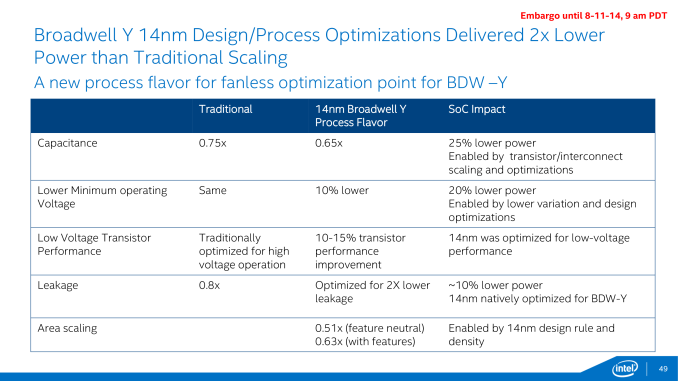
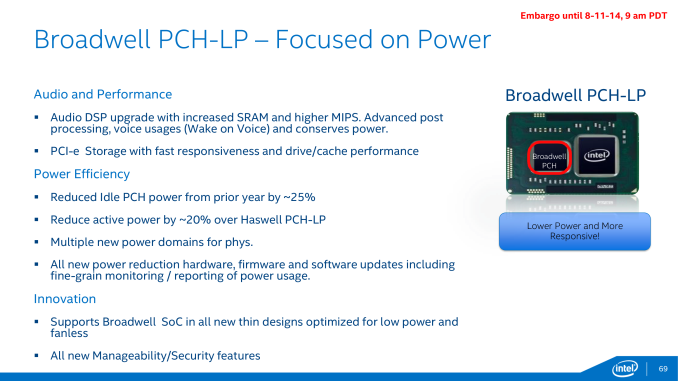
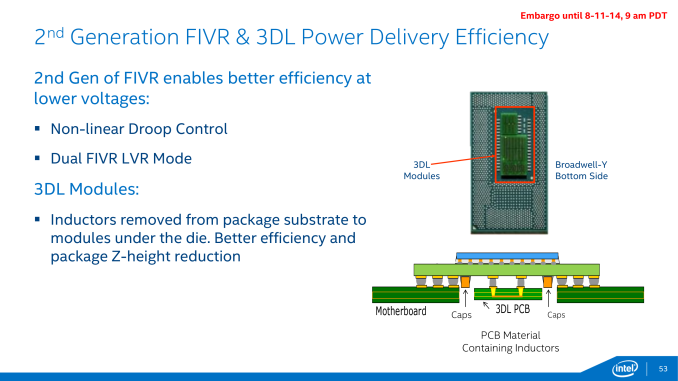

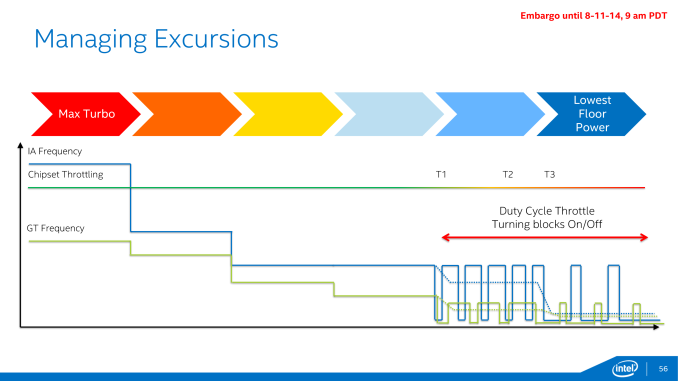








158 Comments
View All Comments
mapesdhs - Monday, August 11, 2014 - link
Yeah, sure, and that's exactly what everyone was saying back when we were waiting for
the followon to Phenom II; just wait, their next chip will be great! Intel killer! Hmph. I recall
even many diehard AMD fans were pretty angry when BD finally came out.
Benchmarks show again and again that AMD's CPUs hold back performance in numerous
scenarios. I'd rather get a used 2700K than an 8350; leaves the latter in the dust for all CPU
tasks and far better for gaming.
Btw, you've answered your own point: if an 8350 is overkill for a game, giving 120fps, then
surely one would be better off with an i3, G3258 or somesuch, more than enough for most
gaming if the game is such that one's GPU setup & sscreen res, etc. is giving that sort of
frame rate, in which case power consumption is less, etc.
I really hope AMD can get back in the game, but I don't see it happening any time soon.
They don't have the design talent or the resources to come up with something genuinely
new and better.
Ian.
wurizen - Monday, August 11, 2014 - link
an fx-8350 isn't holding anything back. come on, man. are you like a stat paper queen obsessor or something? oh, please. an fx-8350 and an amd r9290 gpu will give you "happy" frame rates. i say happy because it i know the frames rates will be high enough. more than good enough even. will it be lower than an i7-4770k and an r90? maybe. maybe the fx-8350 will avg 85 fps on so and so game while the i7-4770k will avg 90 fps. boohoo. who cares about 5 more frames.also, while you mention i3 as a sufficient viable alternative to an fx-8350. remember that the cost will probably be about the same. and fx-8350 is like $190. maybe the i3 is 20 dollars less. but, here's the big but, an i3 is not as good as an fx-8350 in video editing stuff and photo editing stuff if one would like to use their pc for more than just games. an fx-8350, while not as power efficient as an i3 (but who cares since we are talking about a desktop) literally has more bang for the back. it has more cores and is faster.
amd will get back in the game. it is just a question of when. an fx-8350 is already toe-to-toe with an i7-2600k, which is no slouch in todays standard. so, amd just needs to refine their cpu's.
as for talent? amd came up with x64, or amd64 before intel. intel developed their own x86-64 later.
the resource that intel has over amd is just die shrinking. that's it. architecturally, an fx chip or the phenom chip before it seems like a more elegant design to me than intel chips. but that's subjective. and i don't really know that much about cpu's. but, i have been around since the days of 286 so maybe i just see intel as those guys who made 286 which were ubiquitous and plain. i also remember cyrix. and i remember g4 chips. and to me, the fx chip is like a great chip. it's full of compromises and promises at the same time.
Drumsticks - Monday, August 11, 2014 - link
I think AMD might have a way back into the game, but the difference right now is way worse than you say.http://www.anandtech.com/bench/product/697?vs=287
FX-8350 trails the 2600k frequently by 10-20% or more (in gaming).
http://www.anandtech.com/bench/product/697?vs=288
i5-2500k beats it just as badly and actually sells for less than the 8350 used on ebay. Games love single threaded power and the 8350 just doesn't have it.
wurizen - Monday, August 11, 2014 - link
the games they have in that comparison are starcraft 2 and dragon age. 47 fps at 768 p for 8350 looks suspect on starcraft 2. what gpu did they use?it's not way worse as i say. omg.
i have an i7-3770k oc'd to 4.1Ghz and a stock FX-8320 at stock. both can run cod: ghost and bf3. haven't tested my other games. might do the starcraft 2 test tomorrow. i don't have the numbers nor care. what ppl need to realize is the actual game experience while playing games and not the number. is the game smooth? a cpu that can't handle a game will be very evident. this means it's time to upgrade. and there are no fx cpu's from amd that can't handle modern games. again, they will trail intel, but that is like a car going at 220mph so that car wins but the other car is going at 190mph and it will lose but realistically and the experience of going at 190mph will still be fast. the good thing is that amd or cpu don't race each other unless you care about benchmarks. but, if you look past the benchmarks and just focus on the experience itself, an fx series cpu by amd is plenty fast enuff.
omg.
silverblue - Tuesday, August 12, 2014 - link
We're well within the realms of diminishing returns as regards standard CPU IPC. AMD has the most to gain here, though with HSA, will they bother?kaix2 - Tuesday, August 12, 2014 - link
so your response to people who are disappointed that broadwell is focused more on TDP instead of performance is to buy an AMD cpu with even lower performance?wurizen - Tuesday, August 12, 2014 - link
well, they don't have to get the fx-9590, which has serverlike cpu of 2008 like tdp or a gpu like tdp of 220 watts. there is a more modest tdp of 125w with the fx8350. all overclockable. seems like a good cpu for tinkerers, pc/enthusiast, gamers and video editors. i don't even think it's a budget cpu. there is the 6-core and 4-core variants which are cheaper. i am also not saying that an fx-8350 is like the best cpu since it's not and falls way down in the benchmark charts. but, it's not a bad cpu at all. it gets the work done (video editing) and let's you play games (wit's a modern cpu after) even though it's sort of 2 yrs old already. the 990FX chipset is even an older chipset. there's something to be said about that and i think im trying to say it. in light of all the news about intel, which we are guaranteed to get every year with each tick and tock... there is that little AMD sitting in the corner with a chipset that hasn't been updated for yrs and an 8-core cpu that's remarkably affordable. the performance is not that low at all. i mean, video editing with it or playing games with it doesn't hamper one's experience. so, maybe one will have to wait a couple more minutes for a video to render in a video editing program versus say an i7-4790k. but, one can simply get up from one's chair and return. instead of staring at how fast their cpu renders a video on the screen.know what i'm saying?
so, yeah. an fx-8350 with an old 990fx mobo and now intel's upcoming broadwell cpu's with z97 chipsets and all the bells and whistles and productivity for either one will probably be similar. also, most video editing programs now will also leverage the gpu so an old fx-8350 w/ a compatible gpu will have help rendering those gpu's....
i guess it's like new doesn't mean anything now. or something. like m2 sata and pci 3.0, which intel chipsets have over amd is kinda superflous and doesn't really help or do much.
know what im saying?
rkrb79 - Tuesday, November 18, 2014 - link
Agreed!!name99 - Tuesday, August 12, 2014 - link
Oh yes, Skylake.Intel has given 5% IPC improvements for every generation since Nehalem, but now Skylake is going to change everything?
If you're one of the ten people on the planet who can actually get value out of AVX-512 then, sure, great leap forward. For everyone else, if you were pissed off at IB, HSW, BDW, you're going to be just as pissed off with Skylake.
DanNeely - Tuesday, August 12, 2014 - link
No, the interest in Skylake is for all the non-CPU speed things promised with it. PCIe 4.0 and a bump from 16 to 20 CPU lanes (for PCIe storage) are at the top of the list. Other expected, but AFAIK not confirmed, benefits include USB3.1 and more USB3.x on the chipset than the current generation. We should have consumer DDR4 with Skylake too; but that's not expected to be a big bump in the real world.